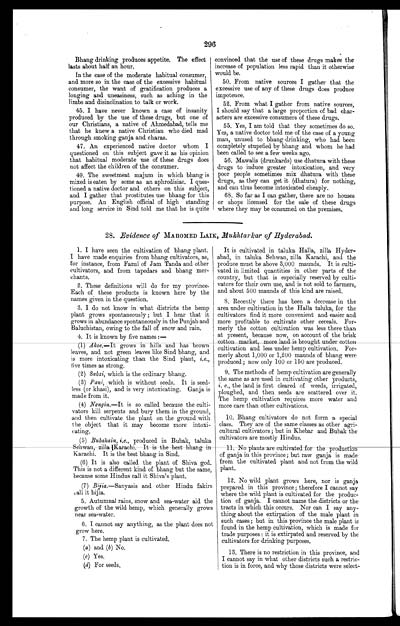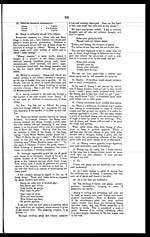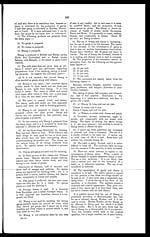Medicine - Drugs > Report of the Indian Hemp Drugs Commission, 1894-1895 > Volume VII > Evidence of Sind witnesses
(314) Page 296
Download files
Individual page:
Thumbnail gallery: Grid view | List view

296
Bhang drinking produces appetite. The effect
lasts about half an hour.
In the case of the moderate habitual consumer,
and more so in the case of the excessive habitual
consumer, the want of gratification produces a
longing and uneasiness, such as aching in the
limbs and disinclination to talk or work.
45. I have never known a case of insanity
produced by the use of these drugs, but one of
our Christians, a native of Ahmedabad, tells me
that he knew a native Christian who died mad
through smoking ganja and charas.
47. An experienced native doctor whom I
questioned on this subject gave it as his opinion
that habitual moderate use of these drugs does
not affect the children of the consumer.
49. The sweetmeat majum in which bhang is
mixed is eaten by some as an aphrodisiac. I ques-
tioned a native doctor and others on this subject,
and I gather that prostitutes use bhang for this
purpose. An English official of high standing
and long service in Sind told me that he is quite
convinced that the use of these drugs makes the
increase of population less rapid than it otherwise
would be.
50. From native sources I gather that the
excessive use of any of these drugs does produce
impotence.
52. From what I gather from native sources,
I should say that a large proportion of bad char-
acters are excessive consumers of these drugs.
55. Yes, I am told that they sometimes do so.
Yes, a native doctor told me of the case of a young
man, unused to bhang drinking, who had been
completely stupefied by bhang and whom he had
been called to see a few weeks ago.
56. Mawalis (drunkards) use dhatura with these
drugs to induce greater intoxication, and very
poor people sometimes mix dhatura with these
drugs, as they can get it (dhatura) for nothing,
and can thus become intoxicated cheaply.
68. So far as I can gather, there are no houses
or shops licensed for the sale of these drugs
where they may be consumed on the premises.
28. Evidence of MAHOMED LAIK, Mukhtarkar of Hyderabad.
1. I have seen the cultivation of bhang plant.
I have made enquiries from bhang cultivators, as,
for instance, from Fazul of Jam Tanda and other
cultivators, and from tapedars and bhang mer-
chants.
2. These definitions will do for my province.
Each of these products is known here by the
names given in the question.
3. I do not know in what districts the hemp
plant grows spontaneously; but I hear that it
grows in abundance spontaneously in the Punjab and
Baluchistan, owing to the fall of snow and rain.
4. It is known by five names:—
(1) Akoe.—It grows in hills and has brown
leaves, and not green leaves like Sind bhang, and
is more intoxicating than the Sind plant, i.e.,
five times as strong.
(2) Sabzi, which is the ordinary bhang.
(3) Pani, which is without seeds. It is seed-
less (or khasi), and is very intoxicating. Ganja is
made from it.
(4) Nangin.—It is so called because the culti-
vators kill serpents and bury them in the ground,
and then cultivate the plant on the ground with
the object that it may become more intoxi-
cating.
(5) Bubakain i.e., produced in Bubak, taluka
Sehwan, zilla Karachi. It is the best bhang in
Karachi. It is the best bhang in Sind.
(6) It is also called the plant of Shiva god.
This is not a different kind of bhang but the same,
because some Hindus call it Shiva's plant.
(7) Bijia.—Sanyasis and other Hindu fakirs
call it bijia.
5. Autumnal rains, snow and sea-water aid the
growth of the wild hemp, which generally grows
near sea-water.
6. I cannot say anything, as the plant does not
grow here.
7. The hemp plant is cultivated.
(a) and (b) No.
(c) Yes.
(d) For seeds.
It is cultivated in taluka Halla, zilla Hyder-
abad, in taluka Selwan, zilla Karachi, and the
produce must be above 3,000 maunds. It is culti-
vated in limited quantities in other parts of the
country, but that is especially reserved by culti-
vators for their own use, and is not sold to farmers,
and about 500 mounds of this kind are raised.
8. Recently there has been a decrease in the
area under cultivation in the Halla taluka, for the
cultivators find it more convenient and easier and
more profitable to cultivate other cereals. For-
merly the cotton cultivation was less there than
at present, because now, on account of the brisk
cottons market, more land is brought under cotton
cultivation and less under hemp cultivation. For-
merly about 1,000 or 1,200 maunds of bhang were
produced; now only 100 or 150 are produced.
9. The methods of hemp cultivation are generally
the same as are used in cultivating other products,
i. e., the land is first cleared of weeds, irrigated,
ploughed, and then seeds are scattered over it.
The hemp cultivation requires more water and
more care than other cultivations.
10. Bhang cultivators do not form a special
class. They are of the same classes as other agri-
cultural cultivators; but in Khebar and Bubak the
cultivators are mostly Hindus.
11. No plants are cultivated for the production
of ganja in this province; but raw ganja is made
from the cultivated plant and not from the wild
plant.
12. No wild plant grows here, nor is ganja
prepared in this province; therefore I cannot say
where the wild plant is cultivated for the produc-
tion of ganja. I cannot name the districts or the
tracts in which this occurs. Nor can I say any-
thing about the extirpation of the male plant in
such cases; but in this province the male plant is
found in the hemp cultivation, which is made for
trade purposes: it is extirpated and reserved by the
cultivators for drinking purposes.
13. There is no restriction in this province, and
I cannot say in what other districts such a restric-
tion is in force, and why those districts were select-
Set display mode to: Large image | Zoom image | Transcription
Images and transcriptions on this page, including medium image downloads, may be used under the Creative Commons Attribution 4.0 International Licence unless otherwise stated. ![]()
| India Papers > Medicine - Drugs > Report of the Indian Hemp Drugs Commission, 1894-1895 > Volume VII > Evidence of Sind witnesses > (314) Page 296 |
|---|
| Permanent URL | https://digital.nls.uk/74911531 |
|---|




